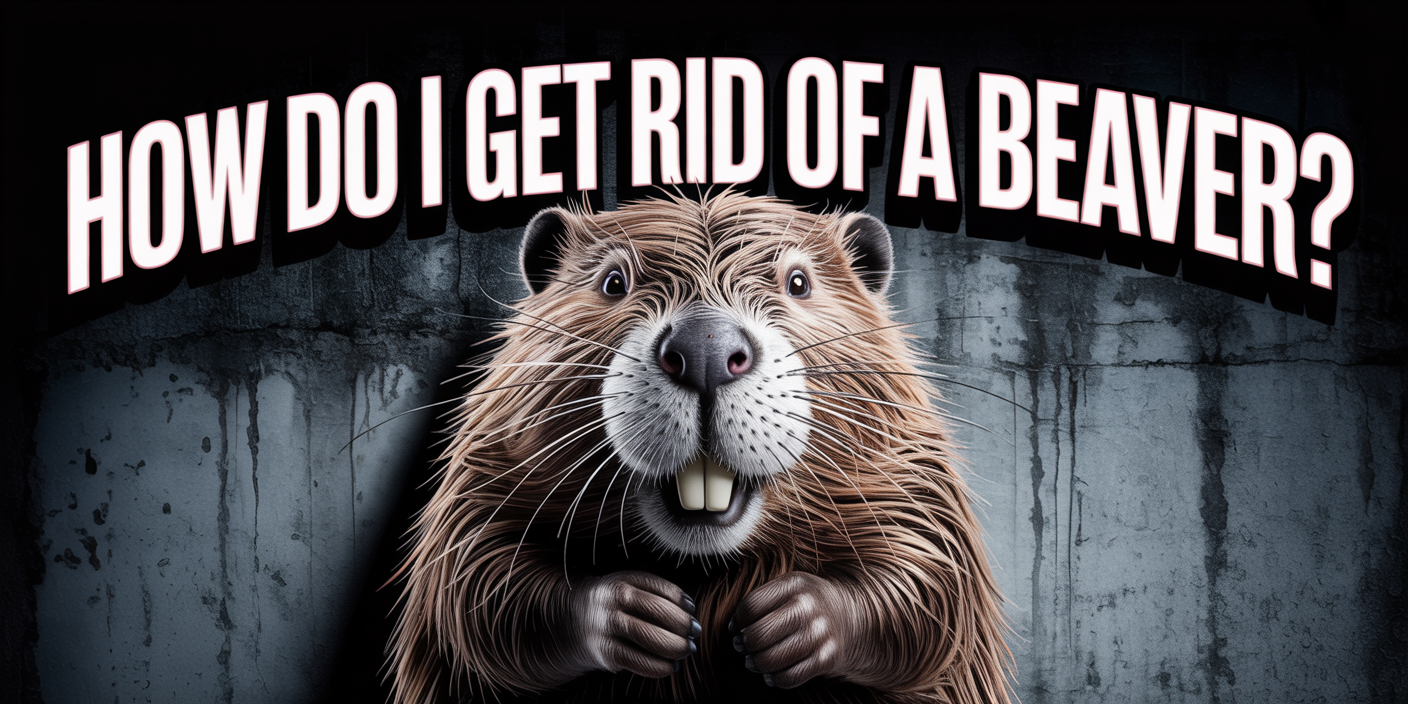“The safest way to get rid of a beaver is by hiring a licensed wildlife removal expert like AAAC Wildlife Removal who can trap and remove it humanely. In Dallas, beaver removal often requires permits and careful handling to avoid property damage and legal issues.”
Beavers might look harmless, but once they settle into your backyard pond or creek in Dallas, they can cause serious problems. These clever rodents are natural dam builders, and in a short amount of time, they can flood your yard, chew through valuable trees, and even block storm drains or irrigation systems. Their nonstop construction can quickly lead to water damage, dead landscaping, and frustrated property owners wondering how to stop the chaos. And if you’ve seen gnawed stumps or sudden flooding near a creekbed, chances are a beaver has already made itself at home.
The big question is: how do you get rid of a beaver safely, legally, and for good? That’s where it gets tricky. Beavers are protected under certain regulations in Texas, and removing them the wrong way can get you in legal hot water. That’s why property owners across Dallas, from Lake Highlands to Oak Cliff, turn to professional wildlife control services like AAAC Wildlife Removal for expert beaver removal. With the right approach and expert help, you can resolve your beaver problem without risking your property—or breaking the law. Let’s walk through exactly what attracts beavers, how to spot the signs, and what your best options are for removal.
Learn more: Who do I call to get rid of beavers?
What Attracts Beavers to Your Dallas Property?
- Nearby Water Sources– Beavers are semi-aquatic and build their homes in or near slow-moving water. Properties along White Rock Creek, Bachman Lake, or any residential retention pond provide ideal conditions for dam construction and food access.
- Softwood Trees and Vegetation– They’re especially fond of willow, cottonwood, poplar, and aspen trees—all of which are common in Dallas landscaping. Beavers use the wood for building and the bark for food, making well-planted yards a big draw.
- Aquatic Plants and Shrubs– Beavers don’t just eat wood. They also feed on water lilies, cattails, and various aquatic plants, along with garden shrubs and backyard ornamentals. If your yard has lush greenery, it’s an open invitation.
- Limited Human Activity– They prefer quiet areas where they won’t be constantly disturbed. Homes backing up to trails, golf courses, greenbelts, or undeveloped land give beavers a safe buffer to build and forage freely.
- Easy Access Points– Beavers are smart—and if your property has broken fencing, shallow banks, or storm drains connecting to nearby water systems, it makes moving in that much easier. Any small water feature can become a starting point for a much bigger problem.
How Do You Know If You Have a Beaver Problem?
Dam or Lodge Construction
The most obvious clue is a freshly built dam or lodge near a creek or pond on your property. These structures are usually made of sticks, mud, and vegetation and can quickly alter the water flow around your home.
Gnawed Trees and Stumps
Beavers leave behind telltale chew marks on tree trunks and stumps shaped like sharpened pencils. If you notice stripped bark or fallen trees near water, it’s likely their handiwork.
Flooding or Blocked Waterways
Sudden water pooling, backed-up culverts, or rising pond levels can signal an active beaver dam. Their construction can reroute natural drainage, creating messy and expensive water issues.
Mud Slides and Tracks
Look for muddy slides leading in and out of the water—these are beaver highways. You may also spot webbed footprints or tail drag marks along the banks or in soft soil.
Nocturnal Activity
Beavers are mostly active at night. If you hear splashing, gnawing, or tree cracking sounds after dark, or spot a shadowy swimmer near your water feature, that’s your confirmation
Why Beavers Are Hard to Remove Without Help
Beavers aren’t your average backyard nuisance—they’re smart, persistent, and surprisingly strong for their size. Once they’ve settled into a water source, they’ll keep reinforcing their dams and lodges even after repeated removal attempts. You can break down their dam one day, and by the next morning, they’ve rebuilt it with twice the effort. Their instinct to build and protect their territory makes them extremely difficult to deter with DIY methods.
On top of that, there are legal concerns. In Texas, certain wildlife—including beavers—are subject to state regulations. Removing them without proper training or permits can result in hefty fines or violations of animal cruelty laws. This isn’t just about setting a trap and hoping for the best. It takes a licensed professional with the right gear, permits, and techniques to handle a beaver problem safely, humanely, and effectively.
Is It Legal to Remove Beavers in Dallas, TX?
In Texas, beaver removal is allowed under certain conditions, especially when they’re damaging private property. However, you can’t just go out and trap or kill a beaver without understanding the laws. According to the Texas Parks and Wildlife Department (TPWD), landowners are generally allowed to manage nuisance wildlife on their property, but there are still rules about trapping methods, relocation, and humane treatment.
For example, live trapping may require a permit, and releasing the animal somewhere else without approval can lead to penalties. It’s also illegal to use certain traps or poisons without the right licensing. This is why working with a professional wildlife removal company is so important. Experts like AAAC Wildlife Removal know exactly how to navigate local regulations and handle beavers in a way that’s safe, legal, and responsible.
Safe and Effective Beaver Removal Methods
Live Trapping & Removing
Licensed professionals use humane live traps placed in beaver pathways. Once captured, the animal is professionally remove—only when legal—to remote wildlife areas. In Texas, relocation often requires permits, ensuring it’s done responsibly and in compliance with regulations.
Flow-Control Devices
Installing pond levelers (like the “beaver deceiver”) allows water to drain steadily through the dam without alerting the beavers. This method protects your property while avoiding a direct conflict with the animals.
Protective Wrapping for Trees
Wrapping vulnerable trees—especially young or softwood species—with heavy-gauge hardware cloth can prevent beavers from chewing through precious landscaping. It’s a proactive and non-lethal deterrent.
Exclusion Fencing
For larger areas, fencing sections of shoreline with sturdy, buried mesh keeps beavers from building directly against your bank or trees. Done right, it’s a long-term, maintenance-free solution.
Pond or Habitat Modification
Reducing food and building materials by removing or trimming preferred trees and certain ground vegetation lowers the site’s appeal to beavers. In some setups, carefully draining small ponds helps eliminate the habitat beavers depend on—although it must be done in accordance with local water regulations.
Why DIY Beaver Removal Is a Bad Idea
Trying to remove a beaver on your own might sound simple—until you realize just how territorial and determined they are. These animals can weigh over 40 pounds, defend their dams aggressively, and rebuild faster than most homeowners can tear things down. Without proper equipment, experience, or understanding of their behavior, you risk injury or making the problem worse by driving the beaver to create new, more damaging pathways.
There’s also the legal side to consider. In Texas, improper trapping or relocation can violate wildlife laws, especially if you use unapproved devices or transport the animal without a permit. What starts as a weekend project could quickly turn into a legal headache. That’s why professional help isn’t just recommended—it’s the smartest and safest path forward when dealing with stubborn, well-established beavers.
Why Hire AAAC Wildlife Removal?
Licensed and Local Beaver Experts
AAAC Wildlife Removal isn’t your average pest control company. Our team is fully licensed to handle nuisance wildlife and trained specifically in humane beaver control methods. We understand the laws, the behavior of local beaver populations, and the best tools to remove them safely and legally from Dallas properties.
Customized Solutions for Dallas Properties
From the creeks in Lakewood to the ponds in University Park, we tailor every removal strategy to fit your specific landscape. Whether you’re dealing with flooding in your backyard or trees being chewed near a commercial site, we provide fast inspections, expert advice, and proven methods that prevent future problems.
End-to-End Service
We don’t just trap and leave. Our services include habitat assessments, damage control, exclusion strategies, and long-term prevention plans. We’ll even help you protect vulnerable trees, restore altered water flow, and document our work in case you need to report it to city officials or HOAs. With us, you get peace of mind from start to finish.
How to Prevent Beavers From Returning
1. Monitor Waterways and Tree Lines Regularly
Keep a close eye on creeks, ponds, and drainage ditches around your property. Watch for early signs of chewing, mud slides, or small dams forming. Catching beaver activity early makes long-term prevention much easier.
2. Wrap or Fence High-Risk Trees
Use hardware cloth or welded wire fencing around the base of softwood trees like willow or cottonwood. This keeps beavers from gnawing through valuable landscaping and reduces the available building materials that keep them coming back.
3. Install Flow Control Devices
If beavers have previously built on your property, installing devices like pond levelers or culvert guards can make it harder for them to alter water flow again. These tools maintain natural drainage while discouraging dam construction.
4. Remove Food Sources and Brush
Trim low-hanging branches and remove unnecessary shrubs or aquatic plants near water edges. Beavers are less likely to stay if food is limited and access to nesting materials is harder to come by.
5. Schedule Regular Wildlife Inspections
Even after removal, beaver families may return or new ones may move in. Having a professional wildlife team, like AAAC Wildlife Removal, check your property regularly ensures any returning activity is handled before it becomes a problem.
Schedule a Beaver Control Inspection in Dallas Today
If you’ve noticed flooding, chewed-up trees, or suspicious activity near your water features, don’t wait for the damage to spread. Beavers work fast—and the longer they’re on your property, the harder they are to remove. Whether you’re in Lake Highlands, Preston Hollow, or just outside the city near Rowlett Creek, we offer local expertise backed by proven results.
At AAAC Wildlife Removal, we make beaver control simple. Our Dallas-area technicians will inspect your property, explain exactly what’s going on, and walk you through the safest, most effective removal options—without pressure or confusion. Don’t gamble with your landscape or water systems. Call us today or request a quote online to get started on protecting your property the right way.




